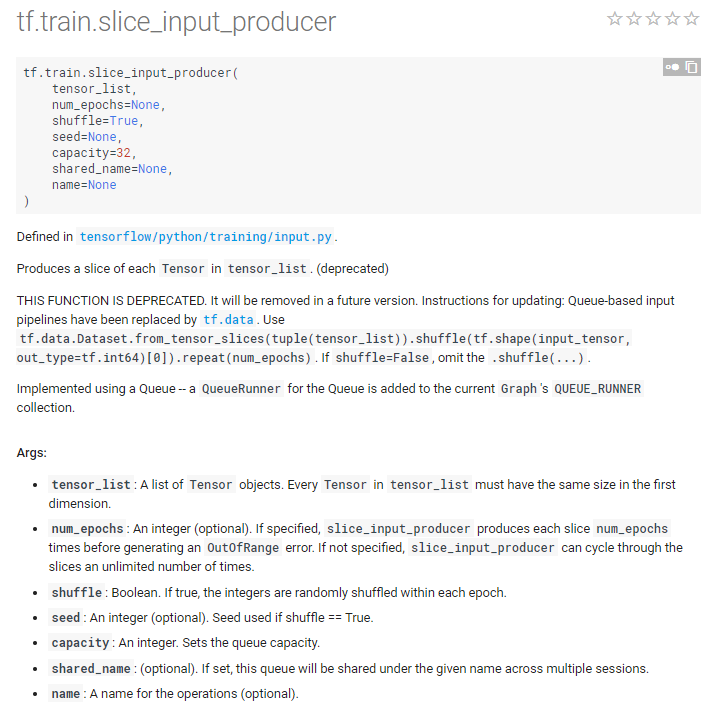tf.train.slice_input_producer处理的是来源tensor的数据
转载自:https://blog.csdn.net/dcrmg/article/details/79776876 里面有详细参数解释
官方说明

简单使用
import tensorflow as tf images = ['img1', 'img2', 'img3', 'img4', 'img5'] labels= [1,2,3,4,5] epoch_num=8 f = tf.train.slice_input_producer([images, labels],num_epochs=None,shuffle=True) with tf.Session() as sess: sess.run(tf.global_variables_initializer()) coord = tf.train.Coordinator() threads = tf.train.start_queue_runners(sess=sess, coord=coord) for i in range(epoch_num): k = sess.run(f) print (i,k) coord.request_stop() coord.join(threads)
运行结果:

用tf.data.Dataset.from_tensor_slices调用,之前的会被抛弃,用法:https://blog.csdn.net/qq_32458499/article/details/78856530
结合批处理
import tensorflow as tf import numpy as np # 样本个数 sample_num=5 # 设置迭代次数 epoch_num = 2 # 设置一个批次中包含样本个数 batch_size = 3 # 计算每一轮epoch中含有的batch个数 batch_total = int(sample_num/batch_size)+1 # 生成4个数据和标签 def generate_data(sample_num=sample_num): labels = np.asarray(range(0, sample_num)) images = np.random.random([sample_num, 224, 224, 3]) print('image size {},label size :{}'.format(images.shape, labels.shape)) return images,labels def get_batch_data(batch_size=batch_size): images, label = generate_data() # 数据类型转换为tf.float32 images = tf.cast(images, tf.float32) label = tf.cast(label, tf.int32) #从tensor列表中按顺序或随机抽取一个tensor input_queue = tf.train.slice_input_producer([images, label], shuffle=False) image_batch, label_batch = tf.train.batch(input_queue, batch_size=batch_size, num_threads=1, capacity=64) return image_batch, label_batch image_batch, label_batch = get_batch_data(batch_size=batch_size) with tf.Session() as sess: coord = tf.train.Coordinator() threads = tf.train.start_queue_runners(sess, coord) try: for i in range(epoch_num): # 每一轮迭代 print ('************') for j in range(batch_total): #每一个batch print ('--------') # 获取每一个batch中batch_size个样本和标签 image_batch_v, label_batch_v = sess.run([image_batch, label_batch]) # for k in print(image_batch_v.shape, label_batch_v) except tf.errors.OutOfRangeError: print("done") finally: coord.request_stop() coord.join(threads)
运行结果:
